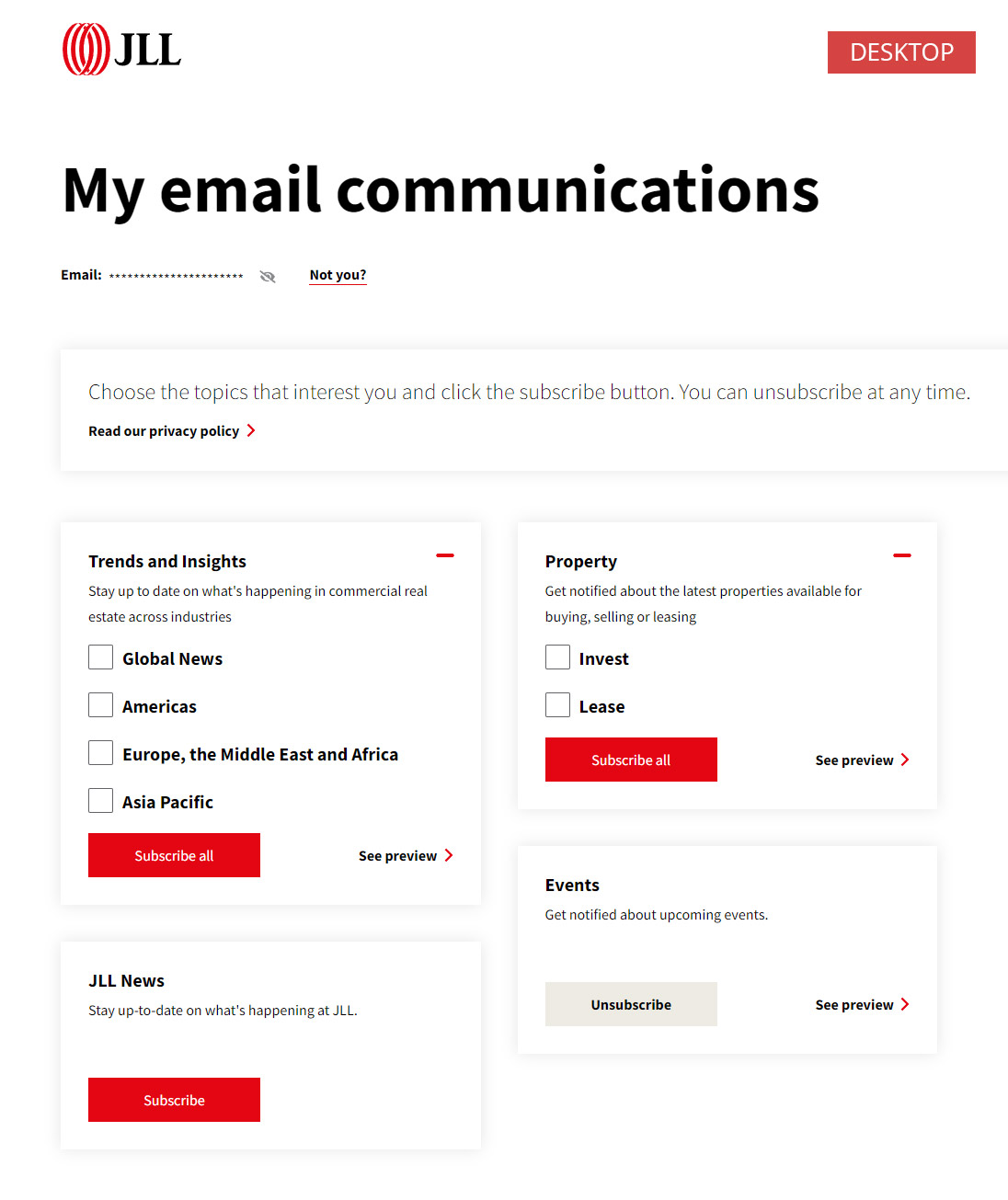Providing Powerful Results
60-90%
Global Opt-Out Saves
Well-designed opt-down pages convert 60-90% of opt-outs to tailored opt-ins.
120+
Operating Countries
Providing localized content experiences in over 120 countries.
30+
Language Configurations
Configured translated preference content in over 30 languages.
Challenges & Solutions
Challenge #1
Tailored Content & Experiences
It’s difficult to provide targeted content to the right audience, through the right channel, and across multiple lines of business. In the absence of automated processes, customer engagement relies on account executives manually tailoring direct communications. Some companies want to provide very specific content for specific functions, while others feature higher level messaging. Regardless, when done manually, there is no way to identify what customers truly want because there is no record of customer subscriptions, interests, or interactions.
Unique audiences include:
- B2B versus B2C
- Free versus paid customers
- Unique customer journeys (e.g., website, email, product trial)
Solution #1
Customer Journey Workshops
To understand data collected by AE’s, we held workshops to create customer journey maps. We leveraged these journey maps to create automated preference collection and value-added communication programs. Additionally, the workshops revealed unique customer touchpoints such as:
- Prospect lifecycle - Awareness, Consideration, and Conversion
- Customer lifecycle - Loyalty and Advisory
- Spot collection - Websites, mobile devices, surveys, events etc.
Deploy Dynamic Forms
We replaced static data collection forms with dynamic forms, such as those created with Eloqua, Salesforce, & Hubspot, etc. Data collected from these forms is used to recommend content-based persona, brand relationship, or interests. Sample forms include brand-consistent registration pages & opt-down pages.
Challenge #2
No Cross-Brand Awareness
Many companies have multiple brands that, in turn, have multiple databases and systems that do not connect to one another.
This leads to low visibility and the inability to identify current customer subscriptions and interests across brands, making a complete customer profile impossible to consolidate. As a result, it is difficult to actively market to and offer relevant content to these customers.
Solution #2
Cross-Brand Awareness
We created an integrated experience where each brand has their own unique preference center but also with easy access to every other brand in a single location. This provides the visibility necessary to make consumers aware of the brand affiliation.
Additionally, brands gain access to customer preferences and data held by other systems across the enterprise, which helps with more personalized connections, data transparency, and cross-sell opportunities.
Branding Flexibility
MyPreferences enables preference centers and opt-down pages to be brand-specific or branded consistently in all instances via configuration. Brand-specific preference centers offer easy access to affiliated brands’ preference centers which provides customers an immersive and consistent user experience.
Challenge #3
International Challenges
Companies face unique challenges when collecting & maintaining consent and preferences globally. The first hurdle is reaching consensus across geographies on a preference framework and customer experience.
The second challenge is localizing experiences by country, state, province, territory, and city to include the appropriate language and brand – even when creating data collection points with Eloqua, Salesforce, Hubspot, etc.
Finally, every communication program must maintain compliance with global opt-out requirements across all customer engagements, as regulated by each region.
Solution #3
Taxonomy & Framework
We conducted interactive workshops to identify which communication preferences add value to the user and business. We collaboratively built the structure, decided which preference options to feature, and which communications to offer each audience.
The result is an inventory of all organizational communications. For a global preferences framework, we typically focus on one region and then scale to a global framework.
This exercise resulted in a global preference framework, opt-down functionality, and lead generation contact forms. MyPreferences makes it easy to incorporate our customers’ brand to drive consistency across the customer journey.
Usability Testing
We completed usability testing in a variety of geographic regions with both low-fidelity and high-fidelity prototypes to ensure the user experience was intuitive. This process identified which preferences to offer each location. We tested:
- Desktop and mobile resolutions
- Pages (e.g., preferences, opt-down, confirmation screens).
- Functionality (e.g., changing locations, opting-in, & opting-out).

